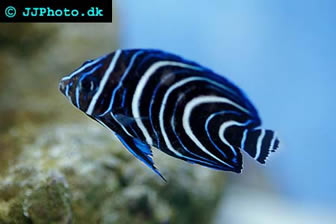Koran Angelfish
Pomacanthus semicirculatus
Pomacanthus semicirculatus is known under several different common names in English, including Koran Angelfish, Blue Koran Angelfish, Semicircle Angelfish, Half-circle Angelfish, and Half-circled Angelfish. The name is often shortened to Koran Angel / Blue Koran Angel / Semicircle Angel / Half-circle Angel / Half-circled Angel.
If you read about the Koran Angelfish in older sources, you might encounter other scientific names for this species than Pomacanthus semicirculatus, such as Pomacanthops semicirculatus, Holacanthus semicirculatus, Holacanthus reginae, Holacanthus lepidolepis, Holacanthus alternans and Pomacanthus koran.
Pomacanthus semicirculatus has not been evaluated for the IUCN Red List of Threatened Species.
Geographical distribution, habitat and habits
The Koran Angelfish is found in the Indo-Pacific. Its geographical range stretches from East Africa and the Red Sea to Samoa. The range proceeds northwards up to southern Japan and southwards down to Western Australia and New South Wales, including Lord Howe Island.
This is a reef-associated species with a depth range of 1-30 meters / 3-100 feet. Juvenile specimens are typically found in shallow protected environments, while the adult fish seek out coastal reefs with prolific coral growth and plenty of hiding spots. It lives singly or in pairs.
Size and appearance
The largest scientifically measured Koran Angelfish was 40.0 cm / 15.7 in.
The juvenile fish has a bluish-black body decorated with concentric semi-circles. The change into adult colouration will typically occur over the size range 8-16 cm / 3-6 in.
The adult fish is brownish on the anterior and posterior third of the body, while the middle part of the body is greenish or yellowish. The sides are adorned with an abundance of spots, and the dorsal and anal fins have filaments with bright yellow tips. The head is yellow-green with sapphire-blue gill margins and eye rings.
The source of the common names Semicircle Angelfish, Half-circle Angelfish and Half-circled Angelfish becomes clear when you look at specimens with a length of roughly 1-3 in / 2.5-7.5 in. During this stage, the body of the fish is adorned with irregular rear semicircles. As the fish grows bigger, the semicircles will develop into sweeping lines.
When the fish is roughly 4-7 in /10-18, it will display a blue pattern similar to Arabic scrip on the tail fin and that is why one of the common names for this species is Koran Angelfish. The pattern consists of blue markings against black between blue lines.
Koran Angelfish care
If you want to keep Angelfish, this is one of the hardiest species you can pick. This doesn’t mean that it is exceptionally hardy; it is just hardy compared to most other angels. You have to keep the water quality really high if you want your Koran Angelfish to thrive. Keep the temperature in the 72-78º F / 22-25.5º C range, the specific gravity at 1.020-1.025 and the pH-value from 8.1 to 8.4.
It is not advisable to keep adult Koran Angelfish in aquariums smaller than 100 gallons / 375 liters. Large specimens (35-40 cm/ 14-15 in) will need even bigger aquariums. The aquarium should contain plenty of live rock to allow the fish to carry out its normal grazing behavior in captivity. Include plenty of suitable hiding spots in the set up.
If you place a Koran Angelfish in a reef aquarium, it may nip at stony corals with large polyps and eat worms, zooanthids, clams and certain soft corals. Juvenile specimens are less risky for a reef aquarium since they primarily feed on algae and tiny animals that live in the algae, but you can never be 100% sure and you must of course take into a account that the fish won’t stay juvenile forever. In the aquarium trade, it is much easier to find juvenile specimens than adult ones.
The Koran Angelfish is aggressive towards it own species and towards other angelfish species. If you still want to try keeping several angels together, you will need a really large and cleverly decorated aquarium. It can also be a good idea to choose specimens that are very dissimilar in size and add the smallest ones first.
Feeding Koran Angelfish
Koran Angelfish is an omnivore species that feeds chiefly on sponges, tunicates and algae in the wild. It is also known to eat corals, worms, crustaceans and molluscs. For juveniles, the bulk of the diet is made up by algae and tiny animals that live among the algae.
Provide your fish with a similar diet in the aquarium, i.e. a diet that contains meaty foods as well as plenty of algae and algae based foods. You can for instance serve live, fresh and frozen shrimps, e.g. mysid shrimp, and other types of crustaceans. Squid and freshly opened shellfish will be highly appreciated. The diet must also contain plenty of algae; encourage natural algae growth, including slime algae and cyanobacteria, and supplement with algae based fish food and/or nori, kombu and similar from oriental food shops. Preferably include both spirulina and marine algae in the diet. This fish is also known to happily devour vegetables, such as zucchini, spinach and green peas. Last but not least, it is advisable to purchase a high-quality angelfish preparation that contains sponge material.
Since the Koran Angelfish is a grazing species, it should be fed small portions throughout the day instead of just one or two large meals.
Breeding Koran Angelfish
The Koran Angelfish is an egg-laying species that scatters the eggs.
Marine Angelfish Articles:
African Flameback Angelfish – Centropyge acanthops
Asfur Angelfish – Pomacanthus asfur
Bicolor Angelfish – Centropyge bicolor
Blueface Angelfish – Pomacanthus xanthometopon
Cherub Angelfish – Centropyge argi
Coral Beauty – Centropyge bispinosa
Emperor Angelfish – Pomacanthus imperator
Flame Angelfish – Centropyge loricula
French Angelfish – Pomacanthus paru
Herald's Angelfish – Centropyge heraldi
Lamarck's Angelfish – Genicanthus lamarack
Potter's Angelfish – Centropyge potteri
Queen Angelfish – Holacanthus ciliaris
Regal Angelfish – Pygoplites diacanthus
Rock Beauty Angelfish – Holacanthus tricolor
Rusty Angelfish – Centropyge ferrugata
Watanabe's Angelfish – Genicanthus watanabei

